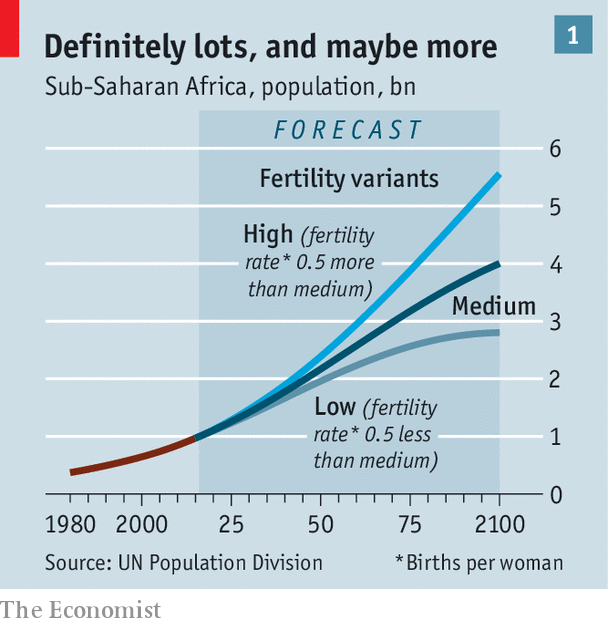That is worrying, although not for the old reasons. In “An Essay on the Principle of Population”, published in 1798, Thomas Malthus claimed that the human population was bound to increase faster than the supply of food, leading to catastrophe. Although Malthus is still admired by some, the green revolution rubbished his hypothesis. The fear now is not that countries will run out of food but that a surfeit of babies will retard their development.
Mr Magufuli is right to suggest that Europe has many old people and could do with more workers to support them. But Tanzania’s many children weigh on its economy, too. Sub-Saharan Africa’s dependency ratio (the population younger than 20 and older than 64 versus the population between those ages) is 129:100, compared with 65:100 in Europe. Sub-Saharan Africa is expected to have a worse dependency ratio than Europe even in 2050.
High fertility can also be seen as a global problem, says Bill Gates, whose foundation (jointly run with his wife, Melinda) will hold a conference next week about the state of the world. Overall, humanity is becoming wealthier. But because birth rates are so high in the poorest parts of the world’s poorest countries, poverty and sickness are that much harder to eradicate. “Kids are being born exactly in the places” where it is hardest to get schooling, health and other services to them, he explains.
There is nothing inherently African about large families. Botswana’s fertility rate is 2.6, down from 6.6 in 1960. South Africa’s rate is 2.4. And although the UN has a good record of predicting global population growth, it has got fertility projections badly wrong in individual countries. Sudden baby busts in countries like Brazil, Iran and Thailand caught almost everyone out. Could Africa also spring a surprise?
The UN’s demographers project that fertility will fall in every single mainland African country over the next few decades. They just expect a much slower pace of change than Asia or Latin America managed when their families were the same size. It took Asia 20 years, from 1972 to 1992, to go from a fertility rate above five to below three. Sub-Saharan Africa is expected to complete the same journey in 41 years, ending in 2054. Its fertility rate is not expected to fall below two this century. Because many Africans marry young (see next article) the generations turn over quickly, leading to fast growth.
The reason the UN expects change to be slow in future is that it has been slow until now. After stagnating economically in the 1990s, countries like Nigeria and Tanzania grew wealthier in the 2000s. But their fertility rates hardly fell (see chart 2). Nor has urbanisation transformed family life as much as you might expect. West Africa is much more urban than east Africa, but has a higher fertility rate.

Three things could drastically change the picture, however. First, more African governments could promote family planning. Ethiopia, Malawi and Rwanda have done so, and their birth rates are dropping faster than average. Perhaps the starkest change is in Kenya. Alex Ezeh of the Centre for Global Development, a think-tank in Washington, remembers showing Kenyan politicians evidence that wealthy people both desired and had small families, whereas the poor wanted large families and ended up with even larger ones. The government invested in clinics and propaganda, to some effect. Household surveys show that 53% of married Kenyan women used effective contraception in 2014, up from 32% in 2003. Kenya’s neighbour, Tanzania, is at least a decade behind.
The second cause for optimism is education. Broadly, the more girls go to school in a country, the lower that country’s birth rate. This seems to be more than just a correlation: several studies, in Africa and elsewhere, have found that schooling actually depresses fertility. To attend school—even a lousy school where you barely learn to read—is to gain a little independence and learn about opportunities that your parents had not envisaged for you.
Researchers at the International Institute for Applied Systems Analysis in Austria suggest that Africa’s schools are about to drive a large change. They point out that education spending weakened in some African countries in the 1980s as governments scrambled to cut budget deficits. Girls’ schooling, which had been increasing, flattened. It is probably not a coincidence that African fertility rates fell little in the 2000s, when that thinly educated cohort reached womanhood. But school enrolments have risen since then. If education really makes for smaller families, that will soon be apparent.
The third profound change would be stability in the Sahel. The semi-arid belt that stretches through Burkina Faso, Chad, Mali, Niger, northern Nigeria and Sudan is lawless in parts and universally poor. Child death rates are still shockingly high in places. Partly as a result, and also because women’s power in the Sahel is undermined by widespread polygamy, people still desire many children. The most recent household survey of Niger, in 2012, found that the average woman thought nine the ideal number.
Progress on all three counts depends mostly on African politicians. It falls to them to create more and better schools, provide security for their people and invest in family planning. They, not foreign observers, need to conclude that their countries would be wealthier if they had rather fewer children. Like so much in Africa, almost everything depends on the quality of government. And that, sadly, is hard to decree.
This article appeared in the
Middle East and Africa section of the print edition under the headline
"Babies are lovely, but..."








